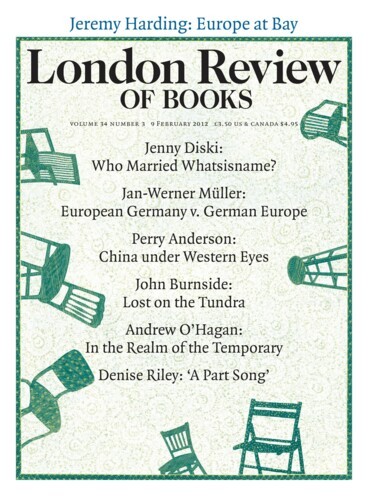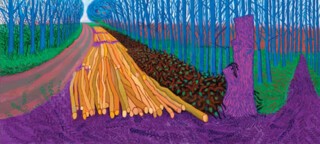The vast David Hockney show at the Royal Academy (until 9 April) is deliberately overwhelming. What it most looks like is an overblown, hyped-up, hyperreal parody of the Royal Academy Summer Exhibition, that super-English annual gathering of the amateur art establishment, to which the buying public with large pocketbooks flock from the Home Counties and beyond. The curator given credit for having the idea for the show, Edith Devaney, also runs the summer exhibition, and everything about the Hockney display, which reaches into all corners of the main floor of Burlington House, is pageantry on a grand scale.
How much better about ourselves it makes us feel that our greatest living artist, now that Lucian Freud is dead, is back from California to celebrate an undervisited corner of agricultural East Yorkshire and make it glorious. The exhibition is full of signs of proud Englishness, and of spring and summer; it thumbs its nose at austerity and recession; it announces itself as the inaugural ‘countdown event’ for 2012’s Cultural Olympiad. If this is the beginning just imagine the end. It’s called A Bigger Picture, partly in a nod to Hockney’s history of showmanship, which really got going after he joined the LA scene with the famous Californian pool paintings of the 1960s (The Splash and A Bigger Splash), and partly because it’s big. At up to 12 feet high and nearly three times as wide, some of the pictures are unsaleably large: even oil oligarchs have only so much space per wall. This is less a show of paintings than a show of the very idea of show.
There is a procession of images from earlier in Hockney’s career designed to demonstrate – weirdly – that he has always been, somewhere at heart, a landscape painter: a post-Pop 1986 photocollage of a highway intersection north of LA, complete with stop signs, flattened box of Bud Light and crushed Pepsi can, is presented as evidence that a shifting perspective is really just a more truthful way of looking at the sky, the ground, the light, the hills. Beyond the collages – past some mostly monochrome views of the Grand Canyon, ultimate unreproducible icon of the tourist sublime – the exhibition fills up with an endless array of paintings of rural England done over the last seven or so years: watercolours, laser-printed iPad sketches and oils, many made quickly outdoors without any preliminary drawing, displayed at sizes ranging from two to 32 feet across. They show English fields in flower, felled trees, hay bales, blossoming hawthorn, snowy farm tracks, roads vanishing through tunnels of hedgerows or into shady woods. The colours are insanely bright, with acres of canvas covered in great primary bands, and with virtuosic curlicues and flourishes to imply floral superabundance and painterly mastery.
Hockney has always wanted to wow. A series of paintings he did for the 1962 Young Contemporaries exhibition while he was a student at the Royal College of Art was entitled ‘Demonstrations of Versatility’, in which, as he once told an interviewer, he ‘deliberately set out to prove I could do four entirely different sorts of picture like Picasso’. In 1999 he had two simultaneous shows in Paris, one at the Musée Picasso (Dialogue avec Picasso) and a very different one down the road at the Pompidou (Espace/Paysage). The second got more attention. Until that point, Picasso – as printmaker, as theatrical designer, as theatrical artist full stop – had been for him a model of inventiveness, facility and ambition, but Hockney seems to have decided that if you’re out to prove you can do anything well, you’re better off not taking all your pointers from someone who does everything well. Landscapes, which Picasso had never been much interested in, would from now on allow him to practise free from the anxiety of influence.
The puff pieces about the Royal Academy exhibition have made much of the fact that at the age of 74 – as if that was about as old as anyone could usefully be – Hockney is making incredible new work at a faster rate than ever before. He has talked of the liberation he feels through painting at scale from the arm, the shoulder, the whole body. His advice to his friend Lawrence Weschler about how to paint on an iPhone was that you shouldn’t fiddle around with your finger but wield your prehensile thumb for maximum speed and dexterity. A film about him made a couple of years ago by Bruno Wollheim – echoing those films of Picasso or Pollock doing their magical thing – has scenes of him painting in the open air like someone inspired, and even if such images aren’t entirely in his control (unlike the striped Breton shirt and flatcap that reads like a Yorkshireman’s take on Picasso’s beret), they add to the aura around the myth. His paintings aren’t just colours on paper or canvas but performances – athletic, spontaneous, spectacular – and the performer is always somewhere in the frame.
He had painted Yorkshire before – The Road to York through Sledmere from 1997 has a nicely Stanley Spencerish feel – but only from the studio: the smaller oils from observation didn’t start appearing until 2004. They look supremely awful. There are some thematic continuities among them: everything has a road or a line that recedes or intersects or rises across the canvas. But their late summer richness or matinal haziness or wispy grass all have an air of pastiche – like a series of jokes at the expense of the diligent Sunday painters. (Though they’re not as kitsch as the iPad paintings of Yosemite National Park, which with their waterfalls and soft-focus greens and greys wouldn’t look out of place in a Thai restaurant.) If these paintings are jokes, they’re cruel and confusing ones, because they appear to be totally serious. They dress themselves up as the fertile and nearly mystical result of a communion with nature. They pretend that all you need to do to be an artist is look, and respond.
But Hockney didn’t get where he is by looking at fields: he got there by looking at pictures. The images that work as images – vile and violent though they may be – are those that acknowledge their jokes, and their precedents. Take Winter Timber, 2009, assembled from 15 canvases (below). There’s decoration in the bracken – a nod to William Morris. The stump, beneath its eyes, has a jagged jaw. There’s a whorl of Van Gogh in the distance and a hint of his deconstructed chair in the arrangement of the laid-out logs. Hockney is and always has been a nodder-to and a cutter-up, and a performance artist whose performance is to perform artistry. One of the misleading things about the Royal Academy exhibition is the way it has made things seem static and sober and monumental that aren’t. Salts Mill near Bradford, which appears here in an oil painting, was once better known as the place to which Hockney faxed a series of prints for in situ assembly while he sat in his studio in the Hollywood Hills. At one point during his experiments in iPad art, he was beaming new pictures of flowers daily to the Fondation Pierre Bergé-Yves Saint Laurent in Paris, where they reappeared on the screens of iPads in a show called Fleurs Fraîches. That was a proper joke.
Send Letters To:
The Editor
London Review of Books,
28 Little Russell Street
London, WC1A 2HN
letters@lrb.co.uk
Please include name, address, and a telephone number.


